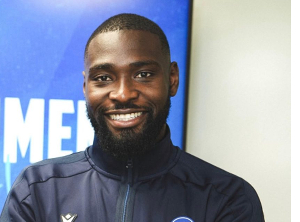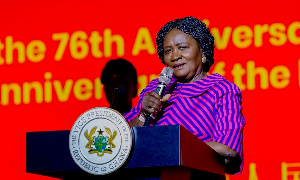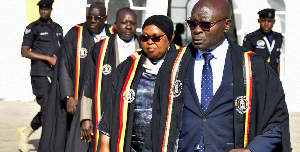Press Release
Ghana Statistical Service today presented the Ghana Living Standard Survey, the first such survey since those measuring poverty levels for 1991 and 1999. The Survey is available on www.gssghana.org.
“Ghana has cut poverty levels from 51.7% in 1991 to 28.5% in 2005. Ghana can achieve the poverty Millennium Development Goal within a year, halving poverty since 1990 – a first in Africa!,” claims Mats Karlsson, Country Director of the World Bank. “Now, let’s accelerate economic growth. It’s proven to be broad-based in Ghana. Let’s congratulate Ghanaians, and redouble efforts, and make sure we fight inequality and create more Ghanaian jobs in the formal economy. No question Ghana can do it!”
Statement at launching event.
Distinguished Chairperson, Mme. Mary Chinery-Hesse, Honorable Minister of Finance and Economic Planning, and MP from North Asante-Akim, Kwadwo Baah-Wiredu, Acting Government Statistician, Prof. Nicholas Nsowah-Nuamah, Distinguished Participants, and a special recognition to all those of you in Ghana Statistical Service who made this survey happen,
Today is a momentous day. We will for the first time since 1991 and 1999 have hard numbers on the evolution of Ghanaian living standards. In particular, we will see the one bottom line figure of poverty levels. What, after the 51.7% in 1991 and 39.5% in 1999, will be the number for 2005?
For Ghanaians, the importance of this number cannot be exaggerated. Sure, it represents only a simple average, and doesn’t itself reflect the hardships that so many people face. And, sure, there are a number of questions that arise, and I’ll point to some in a moment. But there is not one other single measurement that we have of anything, including economic growth, that is more reliable to confirm whether the country is going in the right direction, or not.
The answer has been provided this morning – 28.5%. Ghana should be very proud. She has accelerated the reduction of poverty. And she can be assured of achieving the poverty Millennium Development Goal far ahead of the 2015 schedule. In fact, my assessment is, that on current trends, Ghana will have achieved the poverty MDG (MDG1) within a year or so. The likelihood that over the couple of years from the 2005/6 measurements to sometime in 2008, the same trend as before will have taken Ghana across the 26% MDG target is high. This comes on the back of private-sector driven growth and focused public policy.
Of course, we won’t know until another 5-7 years from now after another living standard survey, but the precise moment matters little. What matters is whether Ghana can sustain, or indeed accelerate, the reduction in poverty, improvements in inequalities, and the attainment of living standards appropriate of Ghana@50, Ghana in the 21st century, Ghana as a middle-income country and eventually even better. It is possible, and the young generation should feel confident: nothing is beyond reach.
The numbers will be poured over in the coming months. What does the headline average poverty level mean? What else does this treasure trove of numbers reveal, spatial differences, gender inequality and much else? How many more poor people would we have had if 1991 poverty levels were still here with us today? (Five million more is the answer.) In absolute terms, how many people were poor in 1991, 1999 and 2005? (7.9, 7.2, 6.2 million is the answer.) What has happened in different parts of the country, the north, the urban areas? Let me highlight a few questions which we now should be asking.
- If growth and public policy have propelled Ghana in this direction, how can we accelerate? What broad-based growth policies have worked, and how can we intensify their implementation? What public policy in service provision, decentralization, health, education and water and sanitation, works best – so we can achieve the other human development MDGs? What can partners do to scale-up what we know works? What is keeping us?
- If poverty still has a woman’s face, what do we need to do to change persistent gender inequalities?
- If poverty is still heavier in the Northern Regions and some rural areas, despite poverty going down there as well, what can we do to accelerate the growth opportunities there, particularly in agriculture and agrobusiness?
- If economic growth is up and poverty down, what about inequality? How can new inequalities be fought? How can the new urban poverty be confronted? Are we even tracking it, so that we know what to fight and how to fight?
- If we know that jobs, better paid jobs in the formal sector, taxes paid, is the best way to a sustainable, equitable growth path – what are we doing to expand the growth and poverty discussion to sustainable jobs creation? What are the prospects for the aspiring young? How can we achieve not only poverty reduction, but income security? How do we measure jobs? How do we incorporate employment into our growth strategies? Elsewhere in the world, the jobs figures are more important to people than growth, inflation or indeed poverty numbers. If that will happen in Ghana, too, how are we preparing? In Ghana, we know we need a broad-based approach, with infrastructure, falling interest rates, better business environment, quality post-basic education, and an onslaught on malaria, and much else. Why not now focus on counting the new formal private sector jobs created year by year?
A last point: This is a moment of glory for the statisticians. Usually starving behind piles of numbers, now is their coming-out time, and it happens to bring good news. But we need the true numbers, whatever they tell us, or we’ll be working in darkness. The Ghana Growth and Poverty Reduction Strategy (GPRSII) has evolved a results framework. It underpins the contractual arrangement between Ghana and its partners, as evidenced in our yearly Consultative Group meetings, where we look at a prioritized Results Matrix, with objectives, baselines and targets, what Government does and what partners do, where we look at resources, both domestic and development assistance, and where we track improvements in aid effectiveness and harmonization. In all, an approach to Results, Resources and Partnership that we know works. But for it to work, we need numbers. And today, we don’t only celebrate a particularly important outdooring of good numbers, but the function of good statistics themselves. As we speak, Government and partners are discussing a new way to support evidence-based public policy making. We are committed to go all the way.
This morning we’ll hear more about the numbers. We can really take encouragement from the progress, from knowing that growth is pro-poor in Ghana, and that public policy makes a difference. For the World Bank, we are extremely proud to be associated with these accelerated developments. Let’s not set a limit, let’s go for change.
Thank you.
In Ghana: Kennedy Fosu kfosu@worldbank.org Tel 229681
In Ghana: Kafu Kofi Tsikata ktsikata@worldbank.org
Press Releases of Friday, 27 April 2007
Source: World Bank












